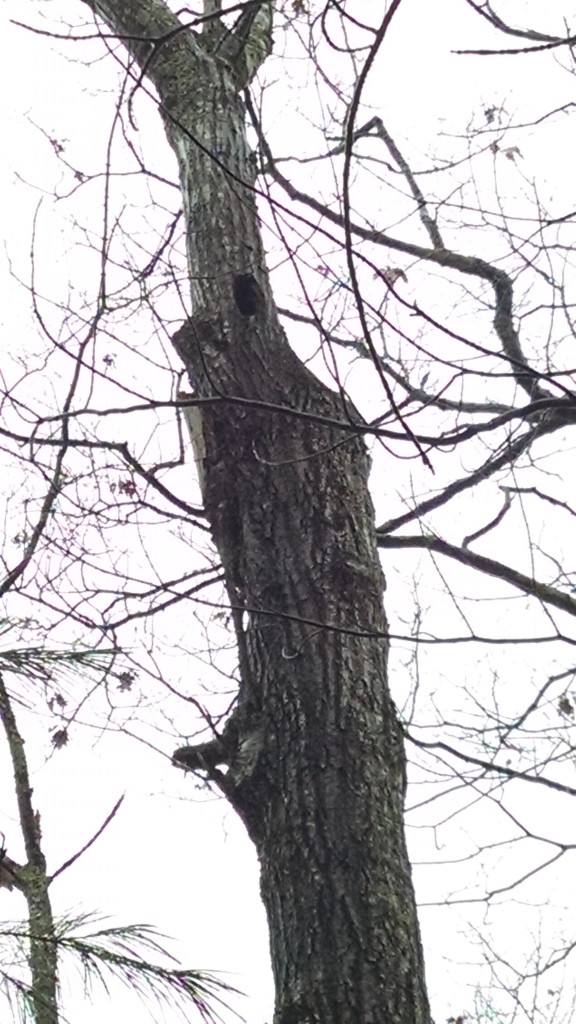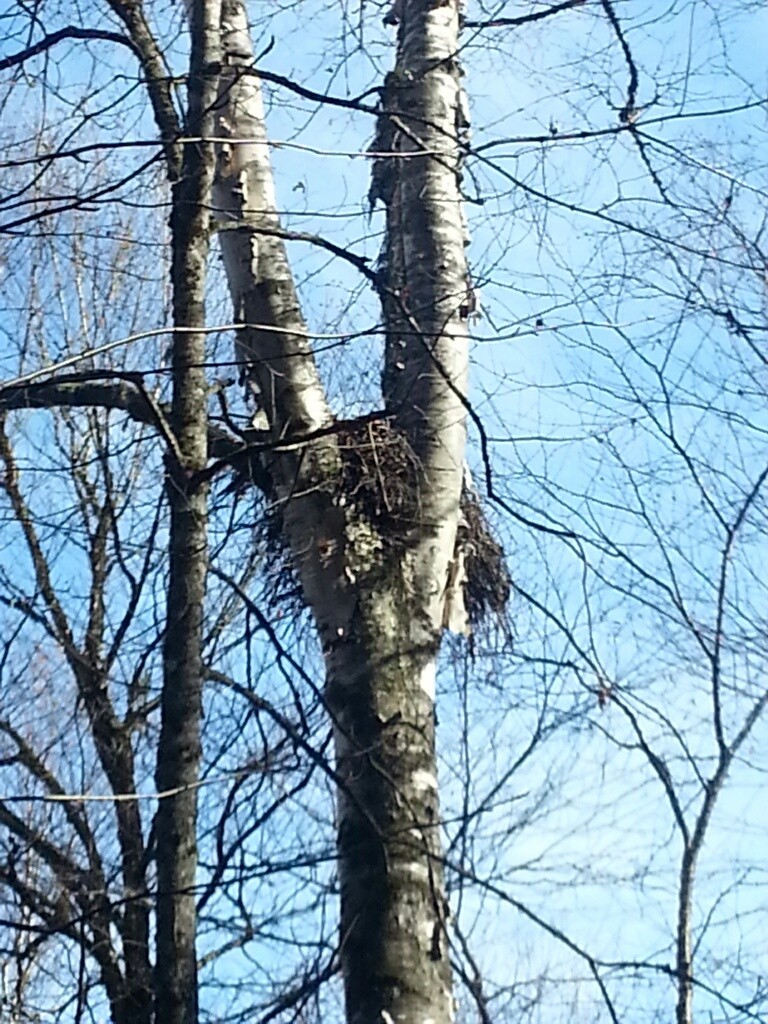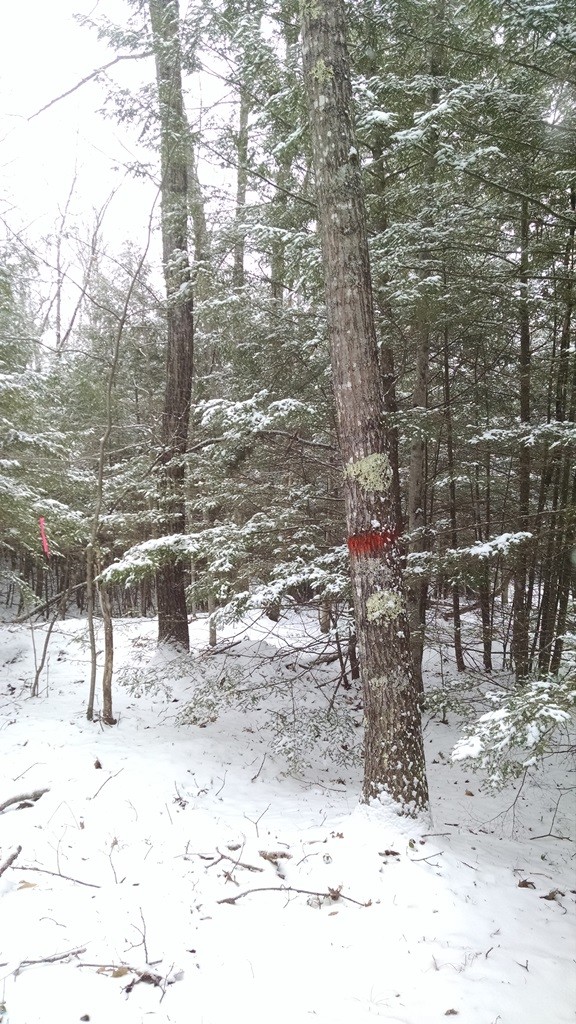April 11, 2016 at 1:47 pm
[caption id="attachment_1389" align="alignright" width="331"] The cavity in this oak tree is useful to a number of species. When thinning stands of trees, biologists look for features such as cavities before cutting.[/caption]
By Eric Hoar, IFW Lands Management Biologist
Inland Fisheries and Wildlife manages for all wildlife, both game and non-game species. One of the tools the Lands Program employs to create or enhance wildlife habitat is timber harvesting. Among other things, harvesting can be used to create young forest for the benefit of species such as grouse, woodcock, New England cottontail or certain songbird species, or it can be used to enhance cover and browse in a deer wintering area. Timber harvesting is not necessarily about the removal of trees but also retention for the benefit of certain species. Individual tree marking plays a major role in indicating to equipment operators which trees to retain and which to remove.
Individual tree marking allows trained personnel the opportunity to evaluate tree species and condition while looking for characteristics beneficial to wildlife species. At right is an image of an oak tree with a cavity useful to a number of species. The cavity is at least 30’ above the ground and well above the visual range of equipment operators. While the cavity certainly represents a significant weak spot, and will likely result in crown breakage in a few years, the decision was made to retain the tree for its value as a nesting cavity.
Another feature IF&W employees typically look to identify and preserve is nests. Many nests are reused year after year. Below is a picture of a stick nest, thickly decorated and probably that of a red shouldered hawk. For this particular species of raptor, disturbance to the site is to be avoided from early March to late July when the nest is active, and limited following July to allow the area to continue to be attractive for further activity. In both instances, the cavity tree and nest trees were retained along with a certain amount of adjacent shelter.
[caption id="attachment_1391" align="alignleft" width="395"]
The cavity in this oak tree is useful to a number of species. When thinning stands of trees, biologists look for features such as cavities before cutting.[/caption]
By Eric Hoar, IFW Lands Management Biologist
Inland Fisheries and Wildlife manages for all wildlife, both game and non-game species. One of the tools the Lands Program employs to create or enhance wildlife habitat is timber harvesting. Among other things, harvesting can be used to create young forest for the benefit of species such as grouse, woodcock, New England cottontail or certain songbird species, or it can be used to enhance cover and browse in a deer wintering area. Timber harvesting is not necessarily about the removal of trees but also retention for the benefit of certain species. Individual tree marking plays a major role in indicating to equipment operators which trees to retain and which to remove.
Individual tree marking allows trained personnel the opportunity to evaluate tree species and condition while looking for characteristics beneficial to wildlife species. At right is an image of an oak tree with a cavity useful to a number of species. The cavity is at least 30’ above the ground and well above the visual range of equipment operators. While the cavity certainly represents a significant weak spot, and will likely result in crown breakage in a few years, the decision was made to retain the tree for its value as a nesting cavity.
Another feature IF&W employees typically look to identify and preserve is nests. Many nests are reused year after year. Below is a picture of a stick nest, thickly decorated and probably that of a red shouldered hawk. For this particular species of raptor, disturbance to the site is to be avoided from early March to late July when the nest is active, and limited following July to allow the area to continue to be attractive for further activity. In both instances, the cavity tree and nest trees were retained along with a certain amount of adjacent shelter.
[caption id="attachment_1391" align="alignleft" width="395"] This stick nest is likely the home of a red-shouldered hawk.[/caption]
Deer wintering area management frequently involves the removal of hardwood species overtopping softwood for the development of cover. A dense over story is the most critical factor regarding deer survival in the winter because snow will not accumulate as deeply as it will outside cover. The second most important factor in management is browse. In the picture below an oak is marked with a non-typical color of paint to indicate its retention. (Insert picture of “Oak in hemlock”) In this particular stand, many hardwoods are overtopping densely developing young hemlock – an ideal species providing cover in a deer wintering area. Some oaks with well-developed crowns were retained to provide a source of hard mast (acorns) during the fall and early winter when deer (turkeys too) could forage for them on the ground. Larger, better developed crowns typically translate to a greater acorn crop. Some oaks, along with other hardwood species like red maple, were harvested not only to release the hemlock they were overtopping but also because they are trees which sprout from the stump providing a source of food for deer once snow covers the ground.
The key to the Department’s management approach is the ability of a trained individual on the ground to visually evaluate habitat in the upper two thirds of a tree which an equipment operator can’t see, as well as the health and condition of the crowns and upper stems to determine either removal or retention. Inland Fisheries and Wildlife favors a deliberate approach to wildlife management on Wildlife Management Areas it is responsible for. While the effort can be rather time intensive, the wildlife benefit is certainly worth it.
[caption id="attachment_1390" align="aligncenter" width="576"]
This stick nest is likely the home of a red-shouldered hawk.[/caption]
Deer wintering area management frequently involves the removal of hardwood species overtopping softwood for the development of cover. A dense over story is the most critical factor regarding deer survival in the winter because snow will not accumulate as deeply as it will outside cover. The second most important factor in management is browse. In the picture below an oak is marked with a non-typical color of paint to indicate its retention. (Insert picture of “Oak in hemlock”) In this particular stand, many hardwoods are overtopping densely developing young hemlock – an ideal species providing cover in a deer wintering area. Some oaks with well-developed crowns were retained to provide a source of hard mast (acorns) during the fall and early winter when deer (turkeys too) could forage for them on the ground. Larger, better developed crowns typically translate to a greater acorn crop. Some oaks, along with other hardwood species like red maple, were harvested not only to release the hemlock they were overtopping but also because they are trees which sprout from the stump providing a source of food for deer once snow covers the ground.
The key to the Department’s management approach is the ability of a trained individual on the ground to visually evaluate habitat in the upper two thirds of a tree which an equipment operator can’t see, as well as the health and condition of the crowns and upper stems to determine either removal or retention. Inland Fisheries and Wildlife favors a deliberate approach to wildlife management on Wildlife Management Areas it is responsible for. While the effort can be rather time intensive, the wildlife benefit is certainly worth it.
[caption id="attachment_1390" align="aligncenter" width="576"] Mature oak trees can provide a bountiful crop of acorns. As this hemlock forest grows, the oak can be cut, and the shoots sprouting from the stump will provide winter browse for deer and moose.[/caption]
Mature oak trees can provide a bountiful crop of acorns. As this hemlock forest grows, the oak can be cut, and the shoots sprouting from the stump will provide winter browse for deer and moose.[/caption]
 The cavity in this oak tree is useful to a number of species. When thinning stands of trees, biologists look for features such as cavities before cutting.[/caption]
By Eric Hoar, IFW Lands Management Biologist
Inland Fisheries and Wildlife manages for all wildlife, both game and non-game species. One of the tools the Lands Program employs to create or enhance wildlife habitat is timber harvesting. Among other things, harvesting can be used to create young forest for the benefit of species such as grouse, woodcock, New England cottontail or certain songbird species, or it can be used to enhance cover and browse in a deer wintering area. Timber harvesting is not necessarily about the removal of trees but also retention for the benefit of certain species. Individual tree marking plays a major role in indicating to equipment operators which trees to retain and which to remove.
Individual tree marking allows trained personnel the opportunity to evaluate tree species and condition while looking for characteristics beneficial to wildlife species. At right is an image of an oak tree with a cavity useful to a number of species. The cavity is at least 30’ above the ground and well above the visual range of equipment operators. While the cavity certainly represents a significant weak spot, and will likely result in crown breakage in a few years, the decision was made to retain the tree for its value as a nesting cavity.
Another feature IF&W employees typically look to identify and preserve is nests. Many nests are reused year after year. Below is a picture of a stick nest, thickly decorated and probably that of a red shouldered hawk. For this particular species of raptor, disturbance to the site is to be avoided from early March to late July when the nest is active, and limited following July to allow the area to continue to be attractive for further activity. In both instances, the cavity tree and nest trees were retained along with a certain amount of adjacent shelter.
[caption id="attachment_1391" align="alignleft" width="395"]
The cavity in this oak tree is useful to a number of species. When thinning stands of trees, biologists look for features such as cavities before cutting.[/caption]
By Eric Hoar, IFW Lands Management Biologist
Inland Fisheries and Wildlife manages for all wildlife, both game and non-game species. One of the tools the Lands Program employs to create or enhance wildlife habitat is timber harvesting. Among other things, harvesting can be used to create young forest for the benefit of species such as grouse, woodcock, New England cottontail or certain songbird species, or it can be used to enhance cover and browse in a deer wintering area. Timber harvesting is not necessarily about the removal of trees but also retention for the benefit of certain species. Individual tree marking plays a major role in indicating to equipment operators which trees to retain and which to remove.
Individual tree marking allows trained personnel the opportunity to evaluate tree species and condition while looking for characteristics beneficial to wildlife species. At right is an image of an oak tree with a cavity useful to a number of species. The cavity is at least 30’ above the ground and well above the visual range of equipment operators. While the cavity certainly represents a significant weak spot, and will likely result in crown breakage in a few years, the decision was made to retain the tree for its value as a nesting cavity.
Another feature IF&W employees typically look to identify and preserve is nests. Many nests are reused year after year. Below is a picture of a stick nest, thickly decorated and probably that of a red shouldered hawk. For this particular species of raptor, disturbance to the site is to be avoided from early March to late July when the nest is active, and limited following July to allow the area to continue to be attractive for further activity. In both instances, the cavity tree and nest trees were retained along with a certain amount of adjacent shelter.
[caption id="attachment_1391" align="alignleft" width="395"] This stick nest is likely the home of a red-shouldered hawk.[/caption]
Deer wintering area management frequently involves the removal of hardwood species overtopping softwood for the development of cover. A dense over story is the most critical factor regarding deer survival in the winter because snow will not accumulate as deeply as it will outside cover. The second most important factor in management is browse. In the picture below an oak is marked with a non-typical color of paint to indicate its retention. (Insert picture of “Oak in hemlock”) In this particular stand, many hardwoods are overtopping densely developing young hemlock – an ideal species providing cover in a deer wintering area. Some oaks with well-developed crowns were retained to provide a source of hard mast (acorns) during the fall and early winter when deer (turkeys too) could forage for them on the ground. Larger, better developed crowns typically translate to a greater acorn crop. Some oaks, along with other hardwood species like red maple, were harvested not only to release the hemlock they were overtopping but also because they are trees which sprout from the stump providing a source of food for deer once snow covers the ground.
The key to the Department’s management approach is the ability of a trained individual on the ground to visually evaluate habitat in the upper two thirds of a tree which an equipment operator can’t see, as well as the health and condition of the crowns and upper stems to determine either removal or retention. Inland Fisheries and Wildlife favors a deliberate approach to wildlife management on Wildlife Management Areas it is responsible for. While the effort can be rather time intensive, the wildlife benefit is certainly worth it.
[caption id="attachment_1390" align="aligncenter" width="576"]
This stick nest is likely the home of a red-shouldered hawk.[/caption]
Deer wintering area management frequently involves the removal of hardwood species overtopping softwood for the development of cover. A dense over story is the most critical factor regarding deer survival in the winter because snow will not accumulate as deeply as it will outside cover. The second most important factor in management is browse. In the picture below an oak is marked with a non-typical color of paint to indicate its retention. (Insert picture of “Oak in hemlock”) In this particular stand, many hardwoods are overtopping densely developing young hemlock – an ideal species providing cover in a deer wintering area. Some oaks with well-developed crowns were retained to provide a source of hard mast (acorns) during the fall and early winter when deer (turkeys too) could forage for them on the ground. Larger, better developed crowns typically translate to a greater acorn crop. Some oaks, along with other hardwood species like red maple, were harvested not only to release the hemlock they were overtopping but also because they are trees which sprout from the stump providing a source of food for deer once snow covers the ground.
The key to the Department’s management approach is the ability of a trained individual on the ground to visually evaluate habitat in the upper two thirds of a tree which an equipment operator can’t see, as well as the health and condition of the crowns and upper stems to determine either removal or retention. Inland Fisheries and Wildlife favors a deliberate approach to wildlife management on Wildlife Management Areas it is responsible for. While the effort can be rather time intensive, the wildlife benefit is certainly worth it.
[caption id="attachment_1390" align="aligncenter" width="576"] Mature oak trees can provide a bountiful crop of acorns. As this hemlock forest grows, the oak can be cut, and the shoots sprouting from the stump will provide winter browse for deer and moose.[/caption]
Mature oak trees can provide a bountiful crop of acorns. As this hemlock forest grows, the oak can be cut, and the shoots sprouting from the stump will provide winter browse for deer and moose.[/caption]Categories